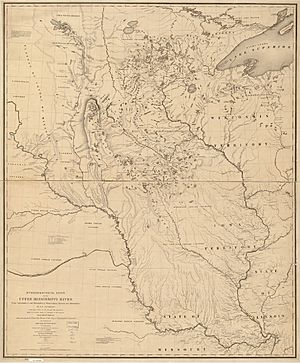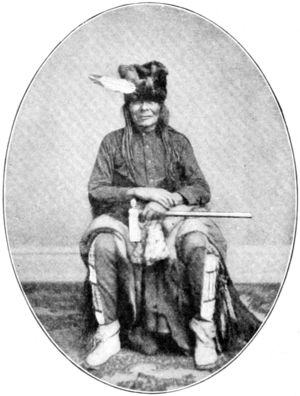Yankton Sioux Tribe facts for kids

Long Fox, To-Can-Has-Ka,
Tachana, Yankton Sioux, 1872 |
|
| Total population | |
|---|---|
| 11,594 enrolled members | |
| Regions with significant populations | |
| Languages | |
| Dakota, English | |
| Religion | |
| traditional tribal religion, Sun Dance, Native American Church, Christianity |
|
| Related ethnic groups | |
| other Eastern Dakota, Western Dakota people |

The Yankton Sioux Tribe of South Dakota is a federally recognized tribe of Yankton Western Dakota people, located in South Dakota. Their Dakota name is Ihaƞktoƞwaƞ Dakota Oyate, meaning "People of the End Village" which comes from the period when the tribe lived at the end of Spirit Lake just north of Mille Lacs Lake. The CNWRR records state the name is alternately spelled with an "E" instead of an "I" or "Ehanktowan".
Historically, the tribe are known for being the protectors of the sacred Pipestone Quarry for the Oceti Sakowin (Dakota/Sioux). Over time the tribe has been referred to as Nakota Sioux which some say is inaccurate and that the Yankton people are Western Sioux. Elsewhere the Yankton people are referred to as Wiciyela Sioux, or middle Sioux.
The tribe maintains a free-ranging bison herd.
Contents
Lewis & Clark
According to local legend, when Meriwether Lewis learned that a male child had been born near the expedition's encampment in what is today southeastern South Dakota, he sent for the child and wrapped the new born baby boy in an American flag during the council at Calumet Bluff in late August 1804. Lewis declared the baby an American. This boy grew up to become a headman (chief) of the Ihanktonwan Dakota (Yankton Sioux), known as Struck By-the-Ree. However, the journals of the expedition make no mention of this incident.
Pressure and land cession
By the late 1850s, pressure to open up what is now southeastern South Dakota to white settlement had become very strong. Struck-by-the-Ree and several other headmen journeyed to Washington, D.C., in late 1857 to negotiate a treaty with the federal government. For more than three and a half months, they worked out the terms of a treaty of land cession. The Treaty of Washington was signed April 19, 1858.
Returning from Washington, Padaniapapi (Struck-by-The-Ree) told his people, "The white men are coming in like maggots. It is useless to resist them. They are many more than we are. We could not hope to stop them. Many of our brave warriors would be killed, our women and children left in sorrow, and still we would not stop them. We must accept it, get the best terms we can get and try to adopt their ways."
For about eleven and a half million acres, a payment of approximately $1.6 million in annuities was to paid over the next 50 years. Specific provisions of the treaty called for educating the tribe to develop skills in agriculture, industrial arts and homemaking. This treaty provided for the removal of the tribe to a 475,000-acre reservation on the north side of the Missouri River in what is now Charles Mix County. (Charles E. Mix was the commissioner who signed for the federal government.) The US Senate ratified the treaty on February 16, 1859 and President James Buchanan authorized it ten days later. On July 10, 1859, the Yankton Sioux vacated the ceded lands and moved onto the newly created reservation.
Reservation
The tribe's reservation is the Yankton Indian Reservation, established in 1853 in Charles Mix County, South Dakota. The tribe has a land base of 36,741 acres. Most of the tribe moved onto the reservation in the 1860s.
Economic development
The tribe owns and operates the Fort Randall Casino and Hotel in Pickstown, South Dakota, and Lucky Lounge and Four Directions Restaurant.
Other major employers include Indian Health Services, the tribe itself, Bureau of Indian Affairs, and Marty Indian School.
Notable tribal members

- Indigenous (band)
- Ella Cara Deloria (linguist, ethnologist)
- Rev. Philip Joseph Deloria, (first Episcopal priest to his people)
- Jacqueline Keeler (writer, activist)
- Maria Pearson (activist, "Rosa Parks of NAGPRA")
- Paul Rouse Sr. (recognized Chief after Death)
- Jimmy Sanchez (Blackbelt Martial Artist/Motivational Speaker)
- Faith Spotted Eagle (elder, activist, and first Native American to receive an electoral vote for president)
- Struck by the Ree (Chief, Headman, Treaty Signer)
- Greg Zephier Sr. (AIM Activist/Activist/Artist/Musician (Vanishing Americans Band)
- Zitkala-Sa (writer, editor, musician, teacher and political activist)
- Nathan Neuharth (author)








